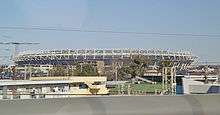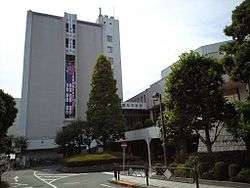Chōfu, Tokyo
| Chōfu 調布市 | |||
|---|---|---|---|
| City | |||
|
Chōfu City Hall | |||
| |||
 Location of Chōfu in Tokyo Metropolis | |||
 Chōfu
| |||
| Coordinates: 35°39′2.21″N 139°32′26.4″E / 35.6506139°N 139.540667°ECoordinates: 35°39′2.21″N 139°32′26.4″E / 35.6506139°N 139.540667°E | |||
| Country | Japan | ||
| Region | Kantō | ||
| Prefecture | Tokyo Metropolis | ||
| Government | |||
| • Mayor | Yoshiki Nagatomo (since July 2002) | ||
| Area | |||
| • Total | 21.58 km2 (8.33 sq mi) | ||
| Population (February 2016) | |||
| • Total | 228,633 | ||
| • Density | 10,590/km2 (27,400/sq mi) | ||
| Time zone | Japan Standard Time (UTC+9) | ||
| City symbols | |||
| • Tree | Cinnamomum camphora | ||
| • Flower | Lagerstroemia indica | ||
| • Bird | Japanese white-eye | ||
| Phone number | 042-481-7111 | ||
| Address | 2-35-1 Kojima-cho, Chōfu-shi, Tokyo-to 182-8511 | ||
| Website | Chōfu city official HP | ||


Chōfu (調布市 Chōfu-shi) is a city located in Tokyo Metropolis, in the central Kantō region of Japan. As of 1 February 2016, the city had an estimated population of 228,663 and a population density of 10,590 persons per km². Its total area was 21.58 square kilometres (8.33 sq mi).
Geography
Chōfu is approximately in the south-center of Tokyo Metropolis, approximately 20 kilometers from downtown Tokyo, on the Musashino Terrace bordered by the floodplains of the Tama River and the Iruma River.
Surrounding municipalities
- Tokyo Metropolis
- Kanagawa Prefecture
History
The area of present-day Chōfu has been inhabited since Japanese Paleolithic times, and numerous remains from the Jōmon, Yayoi and Kofun periods have been discovered. During the Nara period, it became part of ancient Musashi Province. During the Sengoku period, the area was frequently contested between the Late Hōjō clan and Uesugi clan. During the Edo period, the area prospered as a post station on the Kōshū Kaidō and as a center for sericulture.
The in post-Meiji Restoration cadastral reform of April 1, 1889, Chōfu Town and neighboring Jindai Village were established within Kanagawa Prefecture. The entire district was transferred to the control of Tokyo Metropolis on April 1, 1893. Jindai was elevated to town status on November 3, 1952, and merged with Chōfu Town on April 1, 1955, to form the present city of Chōfu.
Economy
Chōfu is primarily a regional commercial center, and a bedroom community for central Tokyo. The headquarters of the Japan Aerospace Exploration Agency (JAXA) are also located in the city.
Transportation
Railway
- Keiō Line
- Sengawa - Tsutsujigaoka - Shibasaki - Kokuryō - Fuda - Chōfu - Nishi-Chōfu
- Keiō Sagamihara Line
Highway
Airport
Education
Colleges and universities:
- University of Electro-Communications
- Tokyo University of Foreign Studies
- Toho Gakuen School of Music
- Shirayuri Women's University
- Jikei University School of Medicine
Primary and secondary education
- Chōfu has 20 public and two private elementary schools, eight public and three private middle schools and four public and three private high schools.
- The American School in Japan also has a campus.
Local attractions
- Jindai Botanical Garden
- Nogawa Park
- Tokyo Stadium (commonly known as Ajinomoto Stadium) in Chōfu hosts soccer games for two J. League teams: F.C. Tokyo and Tokyo Verdy.
Every July, Chōfu hosts the Chōfu City Fireworks Festival, attended by as many as 300,000 people along the banks of the Tamagawa River. The tiny Fuda Station on the Keio Line is inundated on this one day with tens of thousands of visitors.
Chōfu has a large cultural centre that supports many groups encouraging the integration of foreigners into Japanese society, providing free Japanese, Shodo, Ikebana, Karate (and many other) lessons.
There is a park and memorial hall commemorating the life of novelist Mushanokōji Saneatsu, a former resident of Chōfu.
For the 1964 Summer Olympics, the city served as part of the route for the athletic 50-kilometer walk and marathon events.[1]
Notable people from Chōfu
- Kondō Isami – Bakumatsu period samurai, born in the village of Kami-Ishihara in Musashi Province, now modern Chōfu
- Shigeru Mizuki - cartoonist, born in Sakaiminato but has lived in Chofu for roughly 50 years
- Saneatsu Mushanokōji – novelist, playwright, poet
- Shutaro Oku – director
- Junji Takada - actor
References
- ↑ 1964 Summer Olympics official report. Volume 2. Part 1. pp. 74-5.
External links
| Wikimedia Commons has media related to Chofu, Tokyo. |
| Wikivoyage has a travel guide for Chofu. |
- Chōfu City official website (Japanese)
- Chōfu City official website (English)


